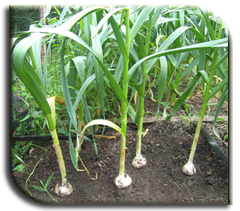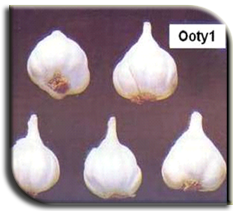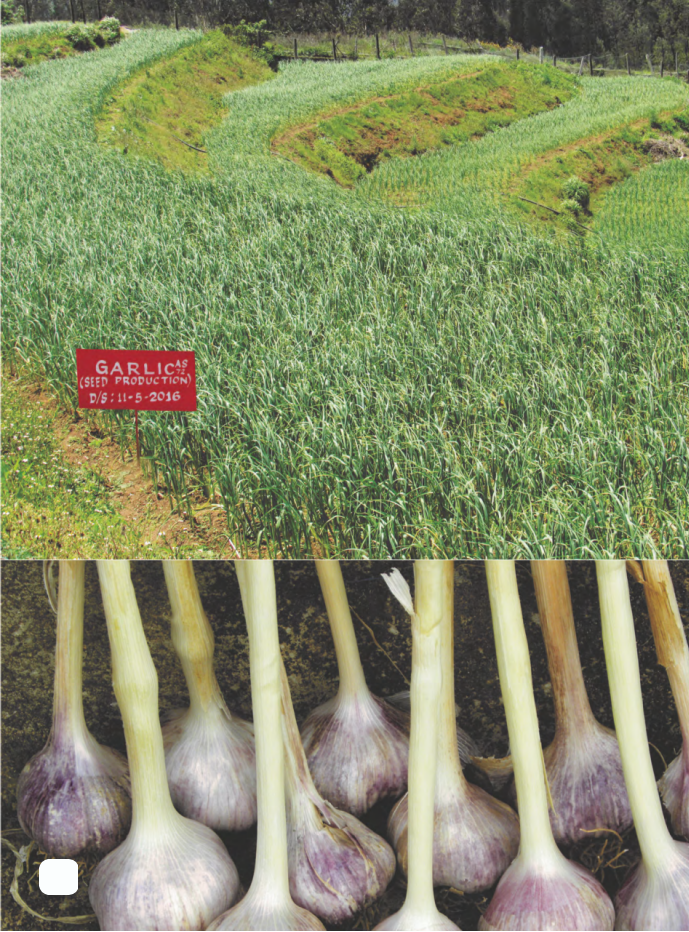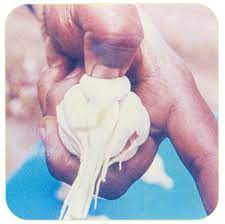Varieties
Ooty 1, Ooty 2
Ooty 1
Released during 1991.
Selection from germplasm.
Yield: 17 t/ha.
Duration: 120-130 days..
Bulb is dull white in colour.
Average bulb weight is 30-40 grams.
Resistance to Thrips & tip drying.
Ooty 2
Released during 2019.
NHRDF varieties
i.e. Agrifound White , Yamuna Safed , Yamuna Safed-2 , Yamuna Safed-3 , Yamuna Safed-4, Yamuna Safed-5 , Agrifound Parvati , and Agrifound Parvati-2 and Yamuna Safed-8 .
Varieties developed by ICAR-DOGR
Bhima Omkar, Bhima Purple.
Other institution varieties
Godavari,Shweta,Phule Baswant,GG 4,VL Garlic 1,VL Lahsun 2
local types
Singapore red, Rajali, Tabiti, Cerole, Madrasii, Mettupalayam
Soil
Garlic can be grown at elevation of 1200–2000 m from the mean sea level. It requires short days, cool (12–18 °C) moist period during vegetative growth. A well drained friable soil rich in organic matter with a pH range of 6 – 7 is ideal. Extreme acidic soils as well as heavy soils are not suited for this crop.
Season
In hilly areas it is grown in two seasons.
1st season: June – July
2nd season: October – November
Seed rate
500 – 600 kg/ha
Preparation of main field
Plough the land to a fine tilth and form ridges and furrows at 30 cm spacing or beds of convenient sizes. Cloves are planted at 15 x 10 cm spacing.
Irrigation
Irrigate before and after planting; life irrigation is given on third day of planting and at weekly intervals of time.
Application of fertilizers
During last ploughing incorporate 50 t/ha of FYM; Apply Azospirillum 2 kg and Phosphobacteria 2 kg/ha, 40:75:75 kg/ha NPK, 50 MgSO4 and 1 ton neem cake as basal and N 35 kg/ha at 45 days after planting.
Controlling rubberisation
Avoid excessive application of N to minimise rubberisation. N should not be applied in the form of Urea. Use Ammonium sulphate. Spray 1500 ppm of CCC or MH on 30th day of planting. Reduce the frequency of irrigation to minimise rubberisation. Apply 0.2 % Boron 0.1 % Sodium molybdate on 30th, 60th and 90th days after planting.
After planting
Weeding should be done on 30th and 60th after planting.
Plant protection
Pests
Thrips
Thrips can be controlled by spraying Methyl dematon 25 EC 1 ml/lit.
Nematode
Nematode can be controlled by the application of Carbofuran 3 G 1 kg a.i./ha 30 days after planting.
Disease
Clove rot
Before planting treat the cloves with Carbendazim 2 g/kg.
PHYSIOLOGICAL DISORDERS
Sprouting of bulbs in the field is noticed sometimes towards the start of maturity stage of bulbs particularly when there are winter rains or excessive soil moisture and nitrogen supply. This disorder is, however, not of permanent nature and varies from variety-to-variety. Early-planting also causes sprouting. Splitting is also noticed sometimes in some varieties, which is due to delayed harvesting or irrigation after long spell of drought. For past few years rubberification problem is noticed in Rajkot area and also Nilgiri hills of Tamil Nadu. It is increasing day-by-day. The actual cause for the disorder was since not identified. Rubberification was totally controlled by application of micronutrients i.e. zinc sulphate and ammonium molybdate. It was also controlled by neem cake insecticides and growth regulator like GA.
The aerial bulbil formation is also quite common in garlic where lower temperature prevails for more periods or there is more temperature variation. It, however, does not affect much on yield or quality of bulbs .
The rubberification and premature sprouting of bulbs are main physiological disorders in garlic. The reasons for these disorders are summarized as under for hill grown garlic in Tamil Nadu.
• Rubberification and premature sprouting of bulbs are noticed mostly in fields which are located in low-lying areas of watershed where there is heavy deposition of nutrients along with silt during heavy rains.
• These problems are severe in garlic fields which are more frequently irrigated than the normal requirements of garlic bulbs.
• With the application of higher levels of nitrogen, there is an increased level of pre-mature sprouting of bulbs which results in splitting and rubberification of bulbs.
• Rubberification incidence also increases when higher level of nitrogen is applied in the form of urea.
• Due to increased levels of nitrogen, in addition to the increased production of rubberized, there is an increased level of thrips incidence in leaves during the later stage of crop. The thrips lacerate leaves and cause severe damage to the crop. Through lacerated wounds by thrips, there is a severe incidence of blast disease, caused by Botrytis allii, when crops is 70-90 days old, which further deteriorates the quality of garlic bulbs.
• Short duration type of garlic (Mettupalayam type) is more susceptible than long duration type (Singapore type).
• Premature sprouting of bulbs is more in the crop (April-August) when there is high moisture level in soil at maturity of crop due to heavy rains.
• Delayed harvest during rainy season has increased premature sprouting and splitting of bulbs.
• Wider spacing of cloves at the time of planting increases uptake of nitrogen and water by the individual plants which increases premature sprouting and rubberification of garlic bulbs.
Harvest
Turning of tops to yellowish or brownish colour and starts drying is the ideal harvest index for harvesting garlic.
Yield
8 – 12 t/ha |
 |
| Garlic Plant |
 |
| Garlic Cloves |
 |
| Ooty1 |
 |
| Ooty2 |
 |
| Garlic Rubbering |
|

